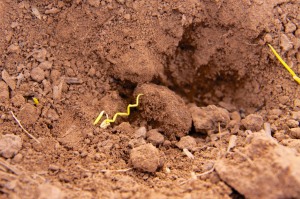Should we plant by seeds per acre or pounds per acre? I will certainly not settle this issue in a single blog post, but I will provide ammunition for those in both camps in the discussion below. Before the discussion begins, I must come clean by acknowledging that when I came to Oklahoma ten years ago, I was solidly in the seeds per acre camp. As a crop consultant I spent most of October every year calibrating clients’ drills each time they changed varieties or field conditions changed. I was certainly not willing to entertain the notion that this could have been wasted time. After reading the published research on the subject, however, I have moved to the pounds per acre camp and will probably remain there unless seed prices increase dramatically OR seed quality improves significantly (I will elaborate below).
Why pounds per acre works
The published research on wheat seed size clearly shows that larger seeds produce more vigorous plants which result in more and larger tillers per plant. Additionally, the research indicates that if you sow the same number of seed of both small and large seeds from the same variety, the large seed will have an approximate 10% better yield potential. While not expressly mentioned in the research, it is reasonable to assume that small seed will produce less fall forage as well. For more reading on this subject consult Kansas Agricultural Experiment Station, Keeping Up With Research numbers 74 (1984) and 101 (1991).
We have established that larger seeds are better on a seed vs. seed basis; however, there are 36% more seeds in a bushel of wheat with 15,000 seeds per pound as compared to a bushel of wheat with 11,000 seeds per pound. So, when sowing by pounds per acre the additional seeds compensate for the smaller seed size and generally results in the same total number of tillers . This compensation effect means that planting by pounds per acre works for a wide range of seed sizes and varieties. This should not be taken as an excuse to plant poor quality seed, as the compensatory effect is not the same if you are sowing shriveled, light, or head-scab damaged seed.
When seeds per acre is a better option
If you are sowing high-quality, large seed, then seeds per acre might be a better option. To get this type of seed usually requires a favorable environment during grain fill, adequate fertility, and a foliar fungicide in-season followed by an aggressive seed cleaning process. I have heard Phil Needham say, and I agree, that 10% seed cleanout is a minimum. Most seed lots require 20 – 40% cleanout to achieve large-seed status. Including a gravity table in the cleaning process will increase seed quality further. The fact of the matter is that most of our wheat seed in the Great Plains simply does not consistently fall into this category. For this reason, if you are sowing “average” quality seed by seeds per acre, then adjust your seeding rate up accordingly to ensure you are not short on tillers.
Seeds per acre may also a better option if you are managing fertility to manipulate final tiller numbers. In this scenario, farmers will sow a set number of seeds per acre and adjust topdress rate and timing to encourage or discourage tillering to reach a desired number of heads at harvest. You can do the same thing when sowing by pounds per acre, but you will need an accurate stand count shortly after emergence. When used in combination with an accurate tiller count in February, a stand count will allow you to accurately estimate potential heads per acre and adjust accordingly.
Finally, if seed costs rise significantly in the future, a switch to seeds per acre might be justified. No one would suggest planting a $300 bag of corn or cotton seed based on pounds per acre. I don’t know what the wheat seed cost threshold is for switching to seeds per acre but would assume that if we ever reach this point seed quality will increase accordingly, making seeds per acre a better option.
